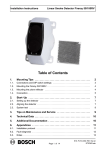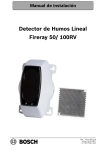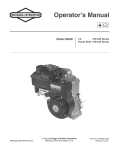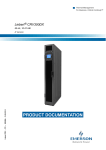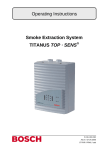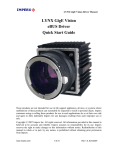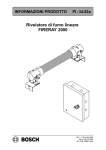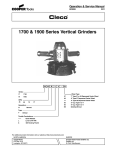Download Bosch Fireray100RV Technical data
Transcript
PRODUCT INFORMATION PI - 34.85 Linear Smoke Detector Fireray 50/100RV Page Page 11 601 -F.01U.002.705 A1.en / 29.12.2004 ST -FIR/ PRM1 / zab Product Information Linear Smoke Detector Fireray 50/100RV PI - 34.85 Table of Contents 1. Product Description . . . . . . . . . . . . . . . . . . . . . . . . . . . . . . . . . . . . . . . . 3 2. Scope of Order . . . . . . . . . . . . . . . . . . . . . . . . . . . . . . . . . . . . . . . . . . . . 3 3. Features . . . . . . . . . . . . . . . . . . . . . . . . . . . . . . . . . . . . . . . . . . . . . . . . . . 4 4. Device Design . . . . . . . . . . . . . . . . . . . . . . . . . . . . . . . . . . . . . . . . . . . . . 5 4.1. Detector . . . . . . . . . . . . . . . . . . . . . . . . . . . . . . . . . . . . . . . . . . . . . . . . . . . . . . . . . . . . 5 4.2. Prism reflector . . . . . . . . . . . . . . . . . . . . . . . . . . . . . . . . . . . . . . . . . . . . . . . . . . . . . . . 5 5. Functional Description . . . . . . . . . . . . . . . . . . . . . . . . . . . . . . . . . . . . . 6 6. Planning Notes . . . . . . . . . . . . . . . . . . . . . . . . . . . . . . . . . . . . . . . . . . . . 7 6.1. Arrangement of the detectors on flat ceilings . . . . . . . . . . . . . . . . . . . . . . . . . . . . 8 6.2. Arrangement of the detectors in a tilted roof . . . . . . . . . . . . . . . . . . . . . . . . . . . . . 9 6.3. Arrangement of the detectors in a saddleback roof . . . . . . . . . . . . . . . . . . . . . . . 9 7. Mounting Tips . . . . . . . . . . . . . . . . . . . . . . . . . . . . . . . . . . . . . . . . . . . . . 10 7.1. Connections and DIP switch settings . . . . . . . . . . . . . . . . . . . . . . . . . . . . . . . . . . . 10 7.2. Mounting the Fireray 50/100 RV . . . . . . . . . . . . . . . . . . . . . . . . . . . . . . . . . . . . . . . 12 7.3. Mounting the prism reflector . . . . . . . . . . . . . . . . . . . . . . . . . . . . . . . . . . . . . . . . . . 12 7.4. Connection . . . . . . . . . . . . . . . . . . . . . . . . . . . . . . . . . . . . . . . . . . . . . . . . . . . . . . . . . . 13 8. Start-Up . . . . . . . . . . . . . . . . . . . . . . . . . . . . . . . . . . . . . . . . . . . . . . . . . . 15 8.1. Setting up the detector . . . . . . . . . . . . . . . . . . . . . . . . . . . . . . . . . . . . . . . . . . . . . . . 15 8.2. Aligning the detector . . . . . . . . . . . . . . . . . . . . . . . . . . . . . . . . . . . . . . . . . . . . . . . . . . 15 8.3. System test . . . . . . . . . . . . . . . . . . . . . . . . . . . . . . . . . . . . . . . . . . . . . . . . . . . . . . . . . 17 9. Notes for maintenance and service . . . . . . . . . . . . . . . . . . . . . . . . . . 18 9.1. Repair . . . . . . . . . . . . . . . . . . . . . . . . . . . . . . . . . . . . . . . . . . . . . . . . . . . . . . . . . . . . . . 18 9.2. Disposal . . . . . . . . . . . . . . . . . . . . . . . . . . . . . . . . . . . . . . . . . . . . . . . . . . . . . . . . . . . . 18 9.3. Additional documentation . . . . . . . . . . . . . . . . . . . . . . . . . . . . . . . . . . . . . . . . . . . . . 18 10. Technical Data . . . . . . . . . . . . . . . . . . . . . . . . . . . . . . . . . . . . . . . . . . . . . 19 11. Appendices . . . . . . . . . . . . . . . . . . . . . . . . . . . . . . . . . . . . . . . . . . . . . . . 20 11.1. Installation protocol . . . . . . . . . . . . . . . . . . . . . . . . . . . . . . . . . . . . . . . . . . . . . . . . . . . 20 11.2. Fault diagnosis . . . . . . . . . . . . . . . . . . . . . . . . . . . . . . . . . . . . . . . . . . . . . . . . . . . . . . 21 Seite 2 von 22 601-F.01U.002.705 A1.en / 29.12.2004 ST-FIR/ PRM1/ zab Product Information Linear Smoke Detector Fireray 50/100RV 1. PI - 34.85 Product Description The Fireray 50/100RV is a linear optical black and white smoke detector. The detector is a retro- operation device, i.e. the transmitter and the receiver are located in one housing with the control unit. A prism reflector is mounted opposite the detector and reflects the infrared beam to the transmitter/receiver combination. If smoke penetrates the section under surveillance, the beam to the receiver, thus the infrared signal received, is smaller. The volume of smoke is assessed and the detector triggers a fire alarm after a specified period of time. The Fireray 50/100RV smoke detector comprises two components: - Compact housing with infrared sensor, receiver and control unit - Prism reflector. There are two Fireray variants: - Fireray 50RV with a range of between 5 m and 50 m - Fireray 100RV with a range of between 50 m and 100 m. If this documentation refers to both variants, they are combined under the designation Fireray 50/100RV. It is also possible to connect a key switch, which is mounted within reach, via the RS- 485 interface. Alarm tests can be triggered using the key switch without having to reach up to the detector. In addition, the set parameters, the detector status and the current signals can be read and the parameters can be changed. An interface adapterand the Data Viewer software (CD) are also required. 2. Scope of Order Product ID LE* Designation 4.998.142.205 ST Linear smoke detector Fireray 50RV - Device with integrated transmitter, receiver and control unit - 1 prism reflector - 1 test filter - 1 connection cable with plug 4.998.142.206 ST Linear smoke detector Fireray 100RV: - Device with integrated transmitter, receiver and control unit - 4 prism reflectors - 1 test filter - 1 connection cable with plug *LE = Delivery unit The key switch, the interface adapter and the Data Viewer software (CD) can be ordered as special merchandise. Seite 3 von 22 601-F.01U.002.705 A1.en / 29.12.2004 ST-FIR/ PRM1/ zab Product Information Linear Smoke Detector Fireray 50/100RV 3. PI - 34.85 Features Compact housing with integrated transmitter, receiver, and control unit Detector ranges: - Fireray 50RV 5 m to 50 m - Fireray 100RV 50 m to 100 m Side detection breadth of 7.5 m on both sides of the beam center line (according to VdS max. 7 m on both sides of the beam center line) Easy to mount; cost- effective retro operation using prism reflectors Areas of application: Historical buildings, churches, museums, shopping malls, factory halls, warehouses, power plants, contaminated environments, etc. The prism reflectors permit angle deviations up to 5 from the center line without signal deterioration. With a max. mounting height of 16 m, the monitored room volume can be up to 22,400 m3 Very low current consumption Operating voltage 10 V DC to 30 V DC Adjustable alarm thresholds/sensitivity Alarm storage or automatic reset possible Alarm output in the form of a potential- free, latching dry relay contact Electronic help for detector alignment and automatic detector calibration procedure Automatic compensation for contamination LED indicators for: - Alarm (red) - Malfunction (yellow) - Operating indicator (flashes yellow once in every 10 s) - End of readjustment due to contamination/aging (flashes yellow once every 2 seconds) Can be connected to the local security network via a control coupler (NSB 100) Cross zoning possible with connection using a NBK 100 LSN and two NSB 100 LSN Fulfills the following regulations: - BS 5839 Part 5 - EN 54 Part 12 - VdS approval number: G 203070 Seite 4 von 22 601-F.01U.002.705 A1.en / 29.12.2004 ST-FIR/ PRM1/ zab PI - 34.85 Product Information Linear Smoke Detector Fireray 50/100RV 4. Device Design 4.1. Detectors 120 mm Detector baseplate Operating mode switch Receiver window 210 mm Gimbal bearing Transmitter window Knurled screw for horizontal adjustment (on right of detector) Operating indicator LEDs Knurled screw for vertical adjustment Detector cover Fig. 1.: Detector side view 4.2. Prism reflector 100 100 ÌÌÌÌÌÌÌÌÌÌÌ ÌÌÌÌÌÌÌÌÌÌÌ ÌÌÌÌÌÌÌÌÌÌÌ ÌÌÌÌÌÌÌÌÌÌÌ ÌÌÌÌÌÌÌÌÌÌÌ ÌÌÌÌÌÌÌÌÌÌÌ ÌÌÌÌÌÌÌÌÌÌÌ ÌÌÌÌÌÌÌÌÌÌÌ ÌÌÌÌÌÌÌÌÌÌÌ ÌÌÌÌÌÌÌÌÌÌÌ ÌÌÌÌÌÌÌÌÌÌÌ Mounting bore Ğ3 mm Fig. 2.: Reflection prism dimensional diagram Seite 5 von 22 601-F.01U.002.705 A1.en / 29.12.2004 ST-FIR/ PRM1/ zab Product Information Linear Smoke Detector Fireray 50/100RV 5. PI - 34.85 Functional Description The transmitter emits an infrared light beam (880 nm) that is focused through a lens and invisible. The light beam is reflected by 180 by the prism reflector mounted opposite and returned to the transmitter/receiver combination. If the IR beam is obscured by smoke and the signal received drops below the selected threshold value for 10 s, the Fireray triggers a fire alarm and the alarm relay closes. The activation threshold can be adjusted to the environmental conditions. Settings 25% (sensitive), 35%, and 50% (non- sensitive) are possible. The alarm relay has two operating modes: With Auto Reset, the alarm relay releases again if the volume of smoke drops below the selected alarm threshold for at least 5 s. In Alarm memory mode, the relay remains active until it is reset. To reset, power is dropped to the detector for at least 5s. Slow changes to the operating states (e.g. aging of the components, contamination of the lenses, etc.) do not cause false alarms; instead, they are balanced out by the automatic gain control. The state of the system is compared with a default reference value every 15 minutes and in case of deviations, compensated automatically up to 0.7 dB/h. If the readjustment limit is reached, any further signal decay will trigger a «malfunction» (DIP switch 2 = on) or an «alarm» (DIP switch 2 = off). If the IR beam is obscured for at least 10 seconds by more than 90% with a sharp signal increase, the fault relay switches. The cause can be a blocking of the beam path, detector misalignment, blocking of the reflector, etc. After eliminating the cause of the malfunction, the fault relay is reset and the detector is reset automatically into the detection - ready state after 5 seconds. The malfunction must be reset at the control unit. The detector has an alarm output in the form of a potential free, latching dry contact. Seite 6 von 22 601-F.01U.002.705 A1.en / 29.12.2004 ST-FIR/ PRM1/ zab PI - 34.85 Product Information Linear Smoke Detector Fireray 50/100RV 6. Planning Notes It is very important that the system be carefully planned and precisely adjusted, to ensure that the detector responds as early as possible. The response time of the system is dependent on the installation location, the volume of smoke generated, the ceiling construction and air ventilation. Note: Since the smoke over a fire source does not just climb vertically upwards, but rather spreads like a mushroom cloud (depending on existing air currents and air pockets), the breadth of the monitoring area is much greater than the diameter of the IR beam. According to VdS 2095 and DIN VDE 0833- 2, the number of light beam smoke detectors must be selected so that the maximum monitoring range A specified in the table is not exceeded. The detectors must be distributed such that no point of the ceiling is further removed from the beam center (horizontal distance) than is specified in column DH The distance between two parallel beams may not be greater than the doubled distance D DH The center line of the monitoring beam may not be closer than 0.5 m to walls, equipment or stored goods. Table 1.: Distances and Monitoring Areas according to VdS Roof pitchα Room height g RH DH A α < 20 α > 20 DL DL up to 6 m 6m 1200 m2 0.3 m to 0.5 m 0.3 m to 0.5 m more than 6 m to 12 m 6.5 m 1300 m2 0.4 m to 0.7 m 0.4 m to 0.9 m more than 12 m to 16 m *) 7m 1400 m2 0.6 m to 0.9 m 0.8 m to 1.2 m DH Greatest permissible horizontal distance of any point of the ceiling to the next-closest beam A Maximum monitoring range per detector (= double the product of the greatest horizontal distance DH and the maximum permissible detector/reflector distance) DL Distance of the detector to the ceiling α *) Angle that the roof/ceiling pitch forms with the horizontal; if a roof has different pitches (e.g. sheds), use the smallest existing pitch With a room height of more than 12 m, it is recommended that you provide a second moni toring level on which the detectors are arranged offset to the first monitoring level. Depends on the use and environmental conditions (e.g. rapid fire development and smoke dissemination) There must be a constant visual line between the detector and reflector, which may not be interrupted by moving objects (e.g. overhead crane). Seite 7 von 22 601-F.01U.002.705 A1.en / 29.12.2004 ST-FIR/ PRM1/ zab Product Information Linear Smoke Detector Fireray 50/100RV PI - 34.85 Heat accumulation under roof surfaces can hinder the travel of climbing smoke to the ceiling. The detector must therefore be mounted below an expected heat accumulation. This can mean that the benchmark values for DL specified in the table must be exceeded. ÉÉÉÉÉÉÉÉÉÉÉÉÉÉÉÉÉÉÉÉÉÉÉÉÉÉÉÉÉ ÉÉÉÉÉÉÉÉÉÉÉÉÉÉÉÉÉÉÉÉÉÉÉÉÉÉÉÉÉ Ceiling Recommended height below the ceiling 30-90 cm Heat accumulation IR beam Smoke cloud If you are uncertain about the correct position, use a smoke test to establish it. 6.1. Arrangement of the detectors on flat ceilings 2 x DH DR DH DH Fireray 50/100 RV Prism reflectors DL DH DH 2 x DH DL DR Horizontal distance to detector and wall 0.5 m to 7.5 m (VdS max. 7.0 m) Distance between two parallel beams max. 15 m (VdS max. 14 m) Distance from the ceiling 0.3 m to 0.9 m Range = distance between detector and reflector: Fireray 50RV: 5 m to 50 m, Fireray 100RV: 50 m to 100 m DH und DL are not dependent on the room height RH (see table 1.). Seite 8 von 22 601-F.01U.002.705 A1.en / 29.12.2004 ST-FIR/ PRM1/ zab PI - 34.85 Product Information Linear Smoke Detector Fireray 50/100RV 6.2. Arrangement of the detectors in a tilted roof Depending on the roof pitch α and the room height RH, the detector and the reflectors must be arranged such that the DL light beam in distance DL runs below the ceiling. DL DL α min. 0.5 m max. 7m max. 14 m min. 0.5 m max. 7 m max. 14 m 6.3. Arrangement of the detectors in a saddleback roof Depending on the roof pitch α DL and the room height RH, the detector and the reflectors must be arranged α DL DL such that light beam in distance DL runs below the ceiling. min. 0.5 m max. 7m max. 14 m max. 14 m min. 0.5 m max. 7 m Depending on local rules and regulations, different distances may be prescribed or permissible if necessary. Seite 9 von 22 601-F.01U.002.705 A1.en / 29.12.2004 ST-FIR/ PRM1/ zab PI - 34.85 Product Information Linear Smoke Detector Fireray 50/100RV 7. Mounting Tips Observe the planning notes in Section 6. Usually, the detector and the reflector are installed at the same height and oriented towards each other. The relatively broad angle of the IR beam eases adjustment and guarantees reliable long- term stability. The mounting surface for the detector must be firm and vibration- free. Metal supports that can be influenced by heat or cold are not suitable for installation. The detector must be installed such that sunlight and artificial light do not beam directly into the detector’s lenses. Normal environmental light conditions have no effect on the IR beam and the evaluation. Mount the reflector on a solid surface at the permissible distance. Ensure that the light beam meets the reflector on the vertical. The reflectors must not be mounted on reflective surfaces such as glass or plain sheet surfaces. Additional reflections lead to malfunctions. For protection against radio interference, use a shielded cable. When you are installing the cable, possible sources of disturbance must be circumvented and the cable must be protected against mechanical damage. A 6 DA mini distributor (product ID 2.798.400.302) is required for wiring. 7.1. Connections and DIP switch settings The operating mode switches, DIP switches and terminal strips for the plug connector (see Fig. 3.) are located on the back of the detector. on Mounting slots off DIP switch Operating mode switch Plug connector 2-pin output for optional key switches Fig. 3.: Reverse side of detector with plug connector, operating mode switch and DIP switch Seite 10 von 22 601-F.01U.002.705 A1.en / 29.12.2004 ST-FIR/ PRM1/ zab PI - 34.85 Product Information Linear Smoke Detector Fireray 50/100RV DIP switches The DIP switches can be accessed through the round recess in the detector base plate. Table 2.: Functions of the DIP switch settings * DIP switch settings Function X X 1 2 3 4 50% threshold X X OFF OFF 35% threshold X X OFF ON 25% threshold X X ON OFF 12% threshold (extremely sensitive, only for special applications!) X X ON ON Alarm relay saves the alarm OFF X X X Automatic reset 5 s after the end of the alarm criterion ON X X X Alarm relay after end of readjustment X OFF X X Fault relay at end of readjustment, no alarm X ON X X The factory presets are shaded in gray. * The recommended settings for connection to a fire panel are marked with X. Use DIP switches 3 and 4 to set the required alarm threshold. The factory setting is moderate sensitivity (35%) for normal environmental conditions. Select a threshold of 50% in very dirty environments. Use DIP switch 1 to select the «Save alarm » or «Auto Reset» function. Select the following settings for connection to a fire panel: - «Alarm relay saves the alarm» - «Fault relay at end of readjustment, no alarm». Plug connector The plug connector can be accessed through the oval recess on the detector base plate. Table 3.: Pin assignment of the 8- pin connector (from left to right) PIN number Wire color 1 Function Not assigned 2 blue 3 yellow Alarm relay, work contact (NO) 4 red Power supply +10 to +30 V DC 5 black Power supply - 6 green Fault relay, normally closed contact (NC) 7 white Fault relay, center contact (COM) 8 Alarm relay, center contact (COM) Not assigned Seite 11 von 22 601-F.01U.002.705 A1.en / 29.12.2004 ST-FIR/ PRM1/ zab Product Information Linear Smoke Detector Fireray 50/100RV PI - 34.85 7.2. Mounting the Fireray 50/100RV To make mounting easier, you can remove the detector cover by gently raising the upper and lower edges. The mounting slots (see Fig. 3.), which are positioned at a 90angle, enable vertical or horizontal mounting of the detector. Locate the four bore holes at the mounting location using the detector base plate. Observe the planning notes and mounting tips! Check the plug connector and the DIP switch settings (see Section 7.1.). Secure the detector using four screws. Refit the detector cover. If a key switch is required, a two- wire cable should be routed from the detector within reach during installation (see Section 7.4. for connection details). 7.3. Mounting the prism reflector Select the mounting location in line with the mounting tips (Section 7.). A prism reflector must be used for the Fireray 50RV, and four prism reflectors arranged in a square for the Fireray 100RV. ÌÌÌÌÌ ÌÌÌÌÌ ÌÌÌÌÌ ÌÌÌÌÌ Fireray 50RV ÌÌÌÌ ÌÌÌÌÌ ÌÌÌÌ ÌÌÌÌÌ ÌÌÌÌ ÌÌÌÌÌ ÌÌÌÌ ÌÌÌÌÌÌÌÌÌ ÌÌÌÌÌ ÌÌÌÌ ÌÌÌÌÌ ÌÌÌÌÌÌÌÌÌ ÌÌÌÌÌÌÌÌÌ Fireray 100RV Fig. 4.: Prism reflectors Each reflector is secured using two mounting bores. Arrange the four reflectors for the Fireray 100RV such that there are no mounting holes in the center (see Fig. 4.). There must be a free visual line between the detector and reflector. The IR light beam must not be blocked by moved objects! Seite 12 von 22 601-F.01U.002.705 A1.en / 29.12.2004 ST-FIR/ PRM1/ zab PI - 34.85 Product Information Linear Smoke Detector Fireray 50/100RV 7.4. Connection Connection of a Fireray 50/100RV using a NSB100 LSN at the fire panel 1 Bridges Br1, Br2 in position 2-3 2 Contacts in open position NSB 100 LSN I1 NLT1 Configuration for LSN: Parameterize the NSB in the control panel to control output KA1-KA2/KR-R-RR and “Control with Fireray”. VII1 I3 -U VII2 I4 +U LSN II1 NLT2 Fireray 50/100 RV Br 1 II2 ⊥ on DIP switch (recommended settings) 1 2 3 1 II3 -U off Br 2 II4 +U 1 2 3 III1 Operating mode switch MALFUNCTION Power supply 10 - 30 V ALARM + - III2 IV1 RR IV2 R 2 V1 KR COM NC NO COM Output for key switch (optional) SA SB I2 ⊥ V2 KA1 V3 KA2 3K3 RE 680 Ω VI1 VI2 UEB gn rd bl UEA wh bl ye Operating mode switches: Prism Targeting Alignment Mode Operating Mode 6 DA mini distributor -U +U -U DIP switch: Functions, see table (below) I3 +U I4 NSB 100 (if voltage drop < 6 V) EV 24 V - 24 V (if voltage drop > 6 V) DIP switch setting * X X DIP switch functions 1 2 3 4 50% threshold X X OFF OFF 35% threshold X X OFF ON 25% threshold X X ON OFF Reserved for later use X X ON ON Alarm relay saves the alarm OFF X X X Automatic reset 5 s after the end of the alarm criterion ON X X X Alarm relay after end of readjustment X OFF X X Fault relay at end of readjustment, no alarm X ON X X The factory presets are shaded in gray. * The recommended settings for connection to a fire panel are marked with X. Seite 13 von 22 601-F.01U.002.705 A1.en / 29.12.2004 ST-FIR/ PRM1/ zab PI - 34.85 Product Information Linear Smoke Detector Fireray 50/100RV Connection of two Fireray 50/100RV to fire panel with cross zoning via an NBK 100 LSN and two NSB100 LSNs 1 Bridges Br1, Br2 on the NSB 100 in position 2-3 (see connection of one Fireray 50/100RV) 2 Contacts in open position Configuration for LSN: Parameterize the NSB in the control panel to control output KA1-KA2/KR-R-RR and “Control with Fireray”. Observe assignment to detector groups/detectors (see example). NBK 100 LSN Fireray 50/100 RV Parameterize, e.g. to 127/1 VI1 DIP switch (recommended settings) Line 1 150/1 cross zoning with 500, current trigger criterion Line 2 500/1 cross zoning with 150, current trigger criterion VI2 Operating mode switch MALFUNCTION Power supply 10 - 30 V ALARM 2 3k92 820 bl V2 COM NC - + NO COM Output for key switch (optional) V1 ye rd bl gn NSB 100 LSN wh Parameterize, e.g. to 127/2 V1 KR V2 KA1 Parameterize, e.g. to V3 KA2 KA1-KA2-KR-150/2 6 DA mini distributor 1 Fireray 50/100 RV DIP switch (recommended settings) Operating mode switch NSB 100 LSN Parameterize, e.g. to 127/3 V2 KA1 Parameterize, e.g. to V3 KA2 KA1-KA2-KR-500/2 1 3k92 bl 2 COM NC 820 rd ye - + NO COM bl MALFUNCTION Power supply 10 - 30 V ALARM Output for key switch (optional) V1 KR gn wh 6 DA mini distributor -U +U -U I3 +U I4 NSB 100 (if voltage drop < 6 V) Seite 14 von 22 EV 24 V - 24 V 601-F.01U.002.705 A1.en / 29.12.2004 ST-FIR/ PRM1/ zab PI - 34.85 Product Information Linear Smoke Detector Fireray 50/100RV 8. Start- Up 8.1. Setting up the detector Start the «Prism Targeting»mode by moving the operating mode switch (see Fig. 3.) up (if the detector is mounted vertically) or to the right (if the detector is mounted horizontally). Connect the power supply. The detector runs in initialization mode for approx. 5 s. As soon as the detector is ready for use, the red LED flashes (once with the Fireray 50RV and twice with the Fireray 100RV). Now direct the detector at the prism, using the two knurled screws, until optimum adjustment is confirmed by a steady yellow LED light. The following LED displays support detector set- up: Yellow LED display Detector status in «Prism Targeting» operating mode off No signal at receiver Flashes -> Flashing frequency increasing Signal is received -> The faster the flashing, the stronger the signal! Steady light Optimum alignment achieved The signal must only move from the reflector to the receiver, under no circumstances must it move to other light sources or reflective surfaces! Cover the prism reflector with a non- reflective material to check. The LED must not be lit. If the yellow LED does not go out, this indicates that a reflector is incorrectly aligned. 8.2. Calibrating the detector Once the optimum detector set- up has been achieved, set the operating mode switch to the center position without displacing the detector. The detector is now in («Alignment Mode»). The detector runs through an automatic configuration procedure to optimize the transmission power and the receiver sensitivity. The following detector statuses may be displayed by the LEDs during this procedure: LED displays Detector statuses in «Alignment Mode» Flashing red Receiver input signal too strong, the transmission power will be reduced. Wait until the LED goes out (max. 20 s). Steady yellow light No signal is being received. Switch back to «Prism Targeting» mode and repeat the detector set-up. Flashing yellow The receiver is receiving a weak signal, the transmission power will automatically be increased. off Transmission power and receiver gain are optimum. Flashing red and yellow Automatic calibration in progress. Seite 15 von 22 601-F.01U.002.705 A1.en / 29.12.2004 ST-FIR/ PRM1/ zab PI - 34.85 Product Information Linear Smoke Detector Fireray 50/100RV Follow the flow chart to perform the calibration process: Switch center Alignment Mode Yellow LED lights up for approx. 5 s No signal: back to detector set-up (Section 8.1.) Steady yellow LED Wait until both LEDs have stopped flashing Turn the knurled screws in one direction and monitor the LED status yellow LED Which LED lights up? red LED Stop turning the knurled screw and wait until the red LED stops flashing Turn the knurled screw slowly in the same direction Turn the knurled screw in the other direction yellow LED Which LED lights up? red LED No LED Repeat the procedure for the other detector axis with the second knurled screw no Both axes adjusted? Do not turn the knurled screw any further y e Check optimum setting: s Yellow LED lights up: 1. With gentle pressure from top/bottom/left/ right on the detector housing. 2. Each time the knurled screws are moved. Exit the Alignment Mode Switch at bottom: Operating Mode Seite 16 von 22 601-F.01U.002.705 A1.en / 29.12.2004 ST-FIR/ PRM1/ zab Product Information Linear Smoke Detector Fireray 50/100RV PI - 34.85 When the calibration procedure is complete, move the operating mode switch (see Fig. 3.) to the bottom (if the detector is mounted vertically) or to the left (if the detector is mounted horizontally). The detector is now in «Operating Mode». The detector runs a calibration test for approx. 60 s. If the yellow LED lights up as a steady light after the test, you must repeat the detector alignment and calibration procedures (see Sections 8.1. and 8.2.). If a detector alarm is reset in normal mode by a disruption to the power supply, the detector automatically runs a calibration test. If the test is failed, the detector remains in the alarm position. If the test is positive, the yellow LED goes out, the fault relay is reset and the detector is returned to normal mode. In normal mode, the yellow LED flashes every 10 s. 8.3. System test The «Alarm» and «Malfunction» functions must be checked before final start - up. Alarm test Hold the test filter in front of the receiver lens (upper or right- hand part of detector). Select a volume of smoke slightly greater than the threshold set for the detector (see Section 7.1.). Make sure that you do not also cover the transmitter -lens. After approx. 10 s, the red LED must light up and the alarm relay must close. With the «Save alarm» detector setting (DIP switch 1 «off»), there must be a reset at the control panel or the power supply must be disrupted for at least 5 s. With the setting «Auto Reset» setting (DIP switch 1 «on»), the alarm is reset automatically if the volume of smoke falls below the selected alarm threshold for at least 5 s. Fault test Cover the reflector with a non- reflective material. After approx. 10 s, the yellow LED must light up and the fault relay must open. As soon as the obstruction is removed, the detector returns to normal mode automatically after approx. 2 s. Seite 17 von 22 601-F.01U.002.705 A1.en / 29.12.2004 ST-FIR/ PRM1/ zab Product Information Linear Smoke Detector Fireray 50/100RV 9. PI - 34.85 Tips on Maintenance and Service For maintenance and inspection work on danger detector systems, in Germany the regulations of DIN VDE 0833 apply, which refer to the maintenance interval according to the manufacturer’s instructions. Bosch ST recommends a functional and visual inspection at least once a year. Maintenance and inspection work should be carried out regularly and by trained personnel. 9.1. Repair In the event of a defect, the entire device is exchanged. 9.2. Disposal Defective devices should be disposed of according to the legal requirements. 9.3. Additional Documentation For those with access rights, the Bosch ST ExtraNet at www.boschsecurity.com/emea/fire contains the most up- to - date product information and the installation manual supplied with the device can be downloaded in PDF format. Seite 18 von 22 601-F.01U.002.705 A1.en / 29.12.2004 ST-FIR/ PRM1/ zab Product Information Linear Smoke Detector Fireray 50/100RV PI - 34.85 10. Technical Data Operating voltage 10 V DC . . . 30 V DC Current consumption: - in standby mode - in alarm/malfunction < 4 mA @ 24 V < 15 mA Reset control by power disruption Alarm relay Fault relay Permissible distance between the detector and the prism reflector: - Fireray 50R - Fireray 100R Optical wavelength >5s Open contact, potential free (2 A @ 30 V DC) Break contact element, potential - free (2 A @ 30 V DC) 5 m to 50 m 50 m to 100m 880nm Adjustable alarm threshold values 2.50 dB (25%) 3.74 dB (35%) 6.02 dB (55%) Detector $0.8 Prism reflector $5.0 Axial deviation tolerance (at 35% sensitivity) Operating temperature - 30C . . . +55C Protection type IP 50 Dimensions (W x H x D) 126 x 210 x 120 mm Weight 670 g Housing: - Color - Material light gray/black ABS, non- flammable VdS ID number G 203 070 Seite 19 von 22 601-F.01U.002.705 A1.en / 29.12.2004 ST-FIR/ PRM1/ zab PI - 34.85 Product Information Linear Smoke Detector Fireray 50/100RV 11. Appendices 11.1. Installation protocol Installation company: Type of object: Installation location: Installation date: Total number of all linear detectors: Detector version: Detector – reflector distance: _________ m Distance of the detector axes to one another _________ m Mounting height _________ m Fireray 50RV Fireray 100RV Mounting surface (e.g. masonry/reinforced concrete/steel beams/wood/etc.) Serial number(s): Reflector size: Supply voltage: _________ V Correct mechanical adjustment of transmitter (when gentle pressure is applied to the detector housing from the left/right/top/bottom, the yellow LED lights up initially): yes no Alarm triggered with absorption film 35% - 50% tested: yes no Fault triggered by disruption of IR beam tested: yes no 1 x (10 x 10 cm) 4 x (20 x 20 cm) DIP switch settings: 1 2 3 4 on off Comments (environmental conditions, e.g. dust, humidity, temperature etc.) Installation tested on: ____________ by: ___________________________ Seite 20 von 22 601-F.01U.002.705 A1.en / 29.12.2004 ST-FIR/ PRM1/ zab Product Information Linear Smoke Detector Fireray 50/100RV PI - 34.85 11.2. Fault diagnosis Fault indicator Fault LED illuminated permanently Possible cause Action Beam path blocked by an obstacle Check and/or ensure free visual line in the area between the detector and the reflector. Reflector is contaminated/covered/ has fallen down. Check the status of the reflector and clean it if necessary. Supply voltage too low. Measure supply voltage directly at detector. Mode sliding switch in upper position («Direct») Set the switch to «Operation» and wait until the 60 s activation routine is complete. Detector set-up changed on switching to «Operation». When operating the sliding switch following the correct adjustment, make sure that the setting is not changed. The limit of automatic gain control has Clean detector lens and reflector and been reached correct mechanical adjustment! Fault LED flashes Alarm LED illuminated permanently No fault message when IR beam is disrupted Alarm triggered when IR beam is disrupted Triggering of false alarms «MODE Switch» sliding switch in up- Align detector vertically and horizontally until the fault LED is permanently per position («Direct») and incomplete detector set-up illuminated. Then continue using fine adjustment (switch in center position)! DIP switch 1 at OFF («Save alarm »), the alarm display remains saved Reset the detector by disrupting the supply voltage for at least 5 s or select «Reset» on the fire panel Beam path (partially) blocked by an obstacle Ensure a free visual line in the area between the detector and the reflector! Detector receives partial IR signal, e.g. via reflective surfaces near the beam axis. Cover reflector with a dark material to test! Check detector’s range of vision for reflective objects! An object placed in the beam path for testing has acted as the reflector. For testing, use a non-reflective material, maintain a greater distance to the detector, cover the reflector as directly as possible. Sensitivity to existing environmental conditions set too high Set a less sensitive alarm threshold (DIP switches 3 and 4): normal= 35%, less sensitive= 50% Seite 21 von 22 601-F.01U.002.705 A1.en / 29.12.2004 ST-FIR/ PRM1/ zab Bosch Security Systems Robert -Koch -Str. 100 D-85521 Ottobrunn Info -Service Telephone: +49 89 6290 - 1039 Fax: +49 89 6290 - 1039 www.boschsecurity.com [email protected] Page 22 of 22






















